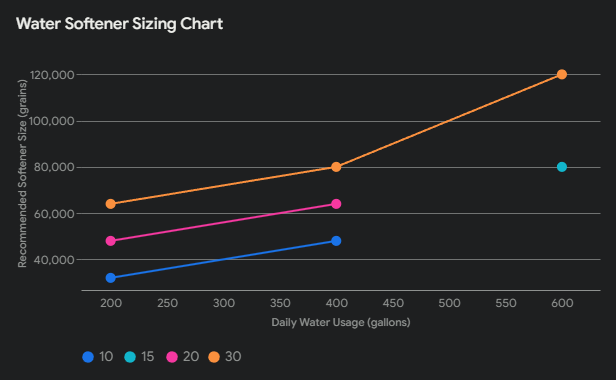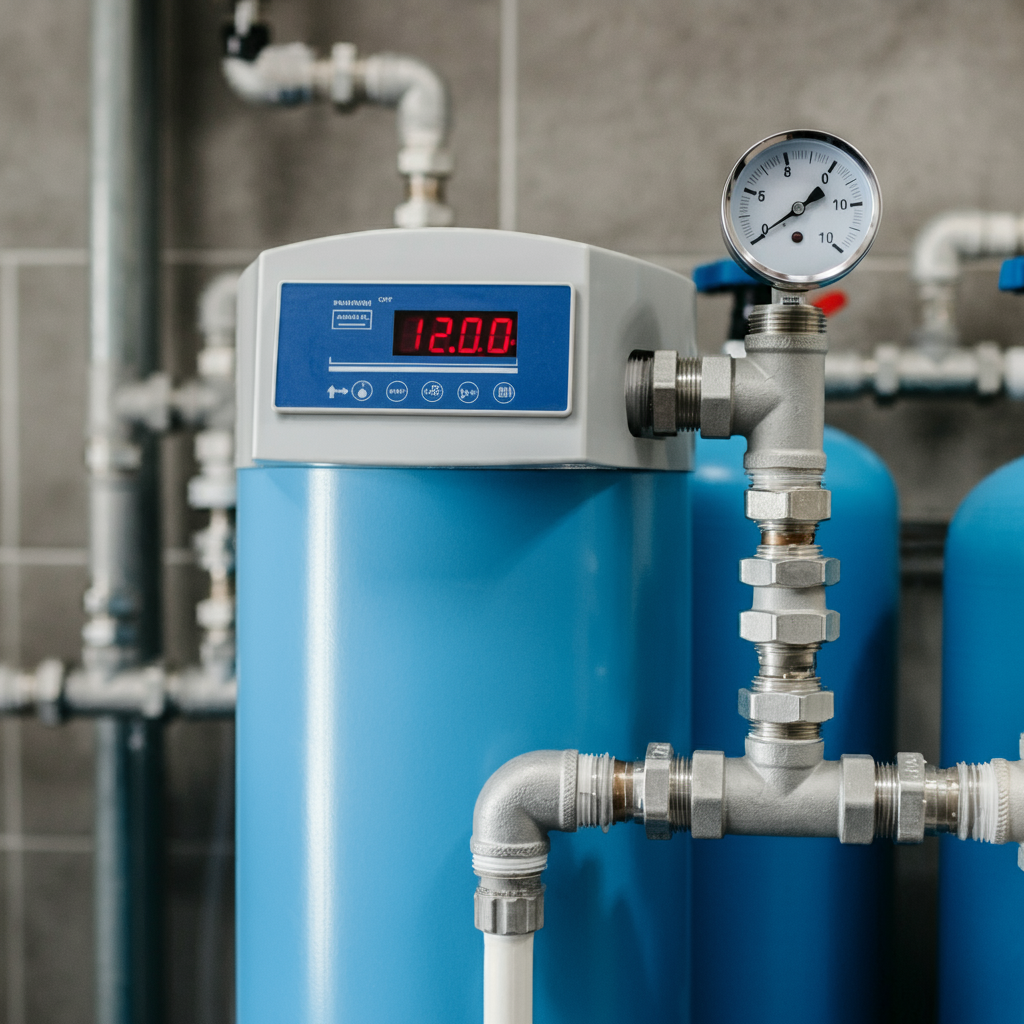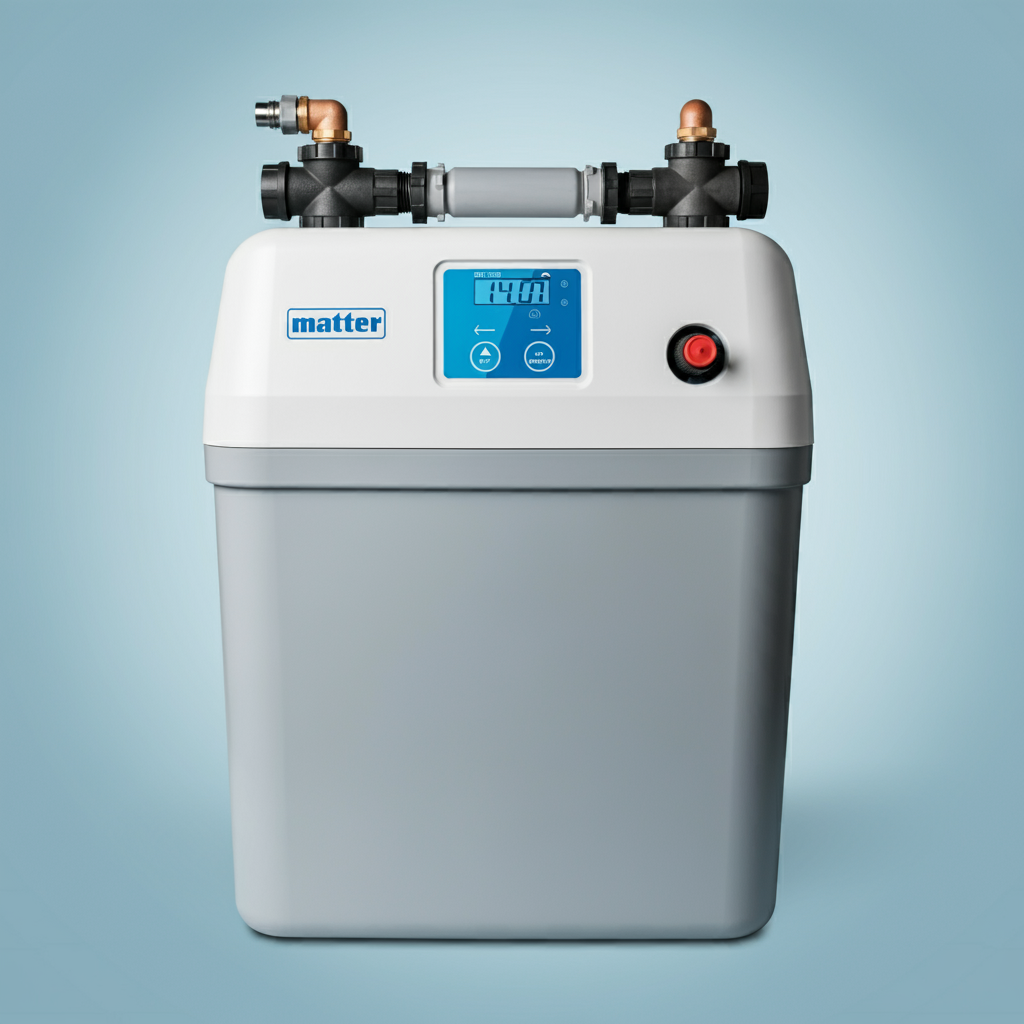The size of a water softener directly impacts its efficiency. An undersized unit will struggle to keep up with your household’s demand, leading to frequent regeneration cycles, wasted resources, and the risk of hard water sneaking through. Conversely, an oversized softener will needlessly consume salt and water, driving up your bills without providing any additional benefits. At WaterSoftenerSizing.com, we understand that choosing the right water softener can feel like navigating a maze of technical jargon and conflicting advice. That’s why we’re committed to making the process simple and straightforward. We believe that everyone deserves the luxury of soft water, and proper sizing is the cornerstone of achieving that goal. A properly sized water softener, like those certified by the Water Quality Association (WQA), operates at peak efficiency, providing you with consistently soft water while minimizing salt and water consumption. This translates to lower operating costs, extended appliance lifespan, and a reduced environmental footprint. Think of it like Goldilocks and the three bears: you don’t want a softener that’s too big or too small, but one that’s “just right.” The sweet spot lies in matching the softener’s grain capacity – the amount of hardness it can remove before needing regeneration – to your household’s specific water usage and hardness level. In this comprehensive guide, we’ll walk you through the intricacies of water softener sizing, debunk common misconceptions, and equip you with the knowledge you need to make an informed decision. Whether you’re a homeowner battling stubborn soap scum or a business owner seeking to protect your investment in plumbing and appliances, we’ll help you find the perfect fit. Let’s dive in and discover how a properly sized water softener can transform your water – and your life.
Efficiency 101: What Makes a Water Softener Truly Efficient?
When we talk about water softener efficiency, we’re not just referring to its ability to transform hard water into soft water. True efficiency encompasses how well the softener performs this task while minimizing resource consumption and operating costs. Let’s break down the key metrics that define a truly efficient water softener:
- Grain Capacity: This is the total amount of hardness minerals (measured in grains) a water softener can remove before it needs to regenerate. It’s like the size of a fuel tank – a larger capacity means you can go longer between refills (or in this case, regeneration cycles).
- Regeneration Frequency: This refers to how often your softener needs to clean itself and recharge its ability to remove hardness. A more efficient softener will regenerate less frequently, saving you money on salt and water.
- Salt Efficiency: This measures how much salt is used per grain of hardness removed. A high salt efficiency means your softener is using salt wisely, reducing waste and minimizing environmental impact.
- Water Usage: The amount of water used during the regeneration process is also a factor in overall efficiency. Efficient softeners use less water during regeneration, helping you conserve this precious resource.
These metrics are interconnected. For example, a softener with a high grain capacity might regenerate less often, but if it uses a lot of salt and water per regeneration, it might not be as efficient overall as a smaller unit with better salt and water usage.
The Hidden Costs of Inefficiency
An inefficient water softener can lead to a cascade of problems, some of which may not be immediately apparent. Frequent regeneration cycles, for instance, not only waste salt and water but also put extra wear and tear on the system, potentially shortening its lifespan. This translates to higher maintenance costs and the need for premature replacement. Moreover, inefficient softeners can fail to fully remove hardness minerals, leading to “hard water breakthroughs.” This means that during periods of high water usage, some untreated hard water can still enter your plumbing system, causing scale buildup, soap scum, and even damage to appliances like water heaters and dishwashers. In contrast, a highly efficient water softener, as certified by organizations like the Water Quality Association (WQA), can save you money in the long run. By optimizing salt and water usage, you’ll see a noticeable reduction in your utility bills. Plus, by effectively removing hardness minerals, you’ll protect your plumbing, appliances, and even your skin and hair from the damaging effects of hard water. To illustrate, consider a study published in the Journal of the American Water Works Association, which found that hard water can reduce the efficiency of water heaters by up to 24%. By investing in an efficient water softener, you can ensure that your appliances operate at their peak performance, saving you energy and money.
Undersized vs. Oversized: The Hidden Costs of Getting it Wrong
Choosing the right size water softener is crucial. Selecting a unit that’s either too small or too large can lead to a host of issues that impact not only the efficiency of the softener but also your wallet and the environment. Let’s delve deeper into the problems associated with undersized and oversized water softeners.
Undersized Softeners: The Constant Struggle
Imagine a water softener as a hardworking employee. An undersized softener is like an employee constantly working overtime, struggling to keep up with the workload. It continuously regenerates, consuming excessive amounts of salt and water, and ultimately wearing itself out prematurely. This results in:
- Frequent Regeneration Cycles: An undersized softener can’t handle the amount of hardness minerals your household produces, forcing it to regenerate far more often than necessary. This not only wastes resources but also puts a strain on the system, reducing its lifespan.
- Higher Salt and Water Bills: Each regeneration cycle requires salt and water. With an undersized softener, you’ll be refilling the salt tank more often and using more water than you should, leading to higher utility bills.
- Hard Water Breakthrough: During peak usage periods, like morning showers or laundry days, an undersized softener might not be able to keep up with the demand. This can result in hard water bypassing the system and entering your plumbing, leading to scale buildup and appliance damage.
Case Study: The Smith Family’s Struggle The Smith family of five, living in an area with moderately hard water, initially opted for a smaller water softener to save on upfront costs. However, they soon realized their mistake. Their softener regenerated almost daily, consuming bags of salt and driving up their water bill. Additionally, they noticed a white film on their dishes and shower doors, a telltale sign of hard water breakthrough. This experience led them to invest in a properly sized softener, resulting in significant savings and consistently soft water.
Oversized Softeners: The Silent Money Pit
On the other end of the spectrum, an oversized softener is like an employee who’s overqualified for their job – they’re capable of doing more, but they’re not being utilized to their full potential. This scenario leads to:
- Wasted Resources: An oversized softener uses more salt and water than necessary during each regeneration cycle, even though it could effectively soften the same amount of water with less. This translates to wasted money and a negative environmental impact due to excessive salt discharge.
- Financial Burden: Larger softeners typically come with higher price tags, both upfront and in terms of ongoing maintenance. Investing in an oversized unit means paying more for features and capacity you don’t actually need.
- Underutilization: An oversized softener rarely operates at full capacity, which can lead to issues like bacterial growth within the system due to stagnant water.
Example: The Joneses’ Surprise Water Bill The Joneses, an older couple with a relatively low water usage, were persuaded to purchase a high-capacity softener with all the bells and whistles. They were assured that bigger was better. However, their excitement quickly turned to dismay when their water bill arrived. The oversized softener was using far more water than their household needed, leading to an unexpectedly high bill. They eventually downsized to a more appropriately sized unit, which not only saved them money but also performed just as effectively.
Finding Your Perfect Fit: How to Size a Water Softener for Optimal Efficiency
Choosing the right water softener size is like finding the perfect pair of shoes – it needs to fit your specific needs and lifestyle. Fortunately, determining the ideal size for your home doesn’t require a crystal ball. It’s a matter of gathering a few key pieces of information and applying a simple calculation. At WaterSoftenerSizing.com, we’ve streamlined this process to make it as easy as possible for you. 
Know Your Numbers
Before you start shopping for a water softener, you’ll need to gather some essential data:
- Water Hardness: This is the first and most crucial piece of the puzzle. Water hardness is measured in grains per gallon (gpg) or milligrams per liter (mg/L) and indicates the concentration of calcium and magnesium minerals in your water. You can obtain this information from your local water utility or by conducting a simple water hardness test at home.
- Daily Water Usage: The next step is to determine how much water your household uses on an average day. This can be estimated based on the number of people in your home and their typical water-consuming activities (showers, laundry, dishwashing, etc.). According to the U.S. Geological Survey, the average person uses about 80-100 gallons of water per day.
- Household Size: The number of people living in your home directly impacts your water usage and, consequently, the size of the water softener you’ll need. Larger households naturally use more water, requiring a softener with a higher grain capacity.
The Calculation (Simplified)
Once you have these numbers, you can use our handy water softener sizing calculator to determine the ideal capacity for your needs. Here’s a simplified version of the calculation:
- Daily Softening Capacity (Grains): Multiply your daily water usage (in gallons) by your water hardness level (in gpg). For example, if your household uses 300 gallons of water per day and your water hardness is 10 gpg, your daily softening capacity would be 3,000 grains.
- Household Adjustment: Multiply the daily softening capacity by the number of people in your household. If your household has 4 people, you’d need a softener with a capacity of 12,000 grains (3,000 grains/day * 4 people).
Our water softener sizing calculator takes into account additional factors like reserve capacity and regeneration frequency to provide you with the most accurate recommendation.
Beyond the Basics: Additional Considerations
While the basic calculation gives you a good starting point, there are a few additional factors to consider when choosing a water softener size:
- High Iron Content: If your water has a high iron content, you’ll need a softener with a larger capacity or one specifically designed to handle iron removal.
- Multiple Bathrooms: Homes with multiple bathrooms might experience simultaneous water usage, requiring a softener with a higher flow rate to maintain consistent water pressure.
- Appliance Usage: If you have high-demand appliances like washing machines or dishwashers, you may need a larger softener to accommodate their water usage.
- Future Expansion: If you plan on adding to your family or increasing your water usage in the future, it’s wise to choose a softener with some extra capacity to accommodate these changes.
Beyond Size: Additional Factors for Maximizing Efficiency
While proper sizing is the cornerstone of an efficient water softener, it’s not the only factor to consider. Several other elements can influence the overall performance and resource consumption of your system. Let’s explore these additional factors to ensure you’re getting the most out of your water softener investment.
Types of Water Softeners: Salt-Based vs. Salt-Free
The two main types of water softeners available on the market are:
- Salt-Based Water Softeners: These are the most common type of water softeners, using sodium chloride (salt) or potassium chloride to regenerate the resin bed and remove hardness minerals. Salt-based softeners are known for their effectiveness in removing high levels of hardness, but they do require regular replenishment of salt and have a slight impact on wastewater due to salt discharge.
- Salt-Free Water Conditioners: These systems don’t actually remove hardness minerals from the water. Instead, they alter their chemical structure, preventing them from forming scale buildup. Salt-free conditioners are a good option for individuals on low-sodium diets or those concerned about the environmental impact of salt. However, they may not be as effective in areas with very hard water.
Choosing the Right Type: The best type of water softener for you depends on your specific needs and preferences. If you have moderately hard water and don’t mind the occasional salt replenishment, a salt-based softener is a reliable choice. However, if you have dietary restrictions or environmental concerns, a salt-free conditioner might be a better fit.
Advanced Features: Boosting Efficiency and Convenience
Modern water softeners come equipped with a range of advanced features designed to optimize efficiency, reduce resource consumption, and enhance user experience:
- Demand-Initiated Regeneration (DIR): Traditional softeners regenerate on a fixed schedule, regardless of actual water usage. DIR technology, on the other hand, monitors water consumption and only initiates regeneration when necessary. This can significantly reduce salt and water usage, as well as extend the lifespan of the softener.
- High-Efficiency Resin: The resin bed inside a water softener is responsible for removing hardness minerals. High-efficiency resin beads require less salt to regenerate, resulting in lower salt consumption and reduced environmental impact.
- Twin Tank Systems: These systems consist of two resin tanks that work in tandem. While one tank is softening water, the other is regenerating, ensuring a continuous supply of soft water even during the regeneration process. This eliminates the risk of hard water breakthrough and provides uninterrupted soft water access.
These features, while not essential, can significantly enhance the efficiency and convenience of your water softener. When choosing a model, consider your budget, water usage patterns, and environmental concerns to determine which features best suit your needs. 
Your Water Softening Journey: Partner with WaterSoftenerSizing.com
Choosing and sizing a water softener is a significant decision. At WaterSoftenerSizing.com, we’re dedicated to guiding you through the process, ensuring you achieve the best possible results for your home or business.
Why Trust WaterSoftenerSizing.com?
Our team of water treatment professionals brings years of experience and expertise to the table. We understand the intricacies of water softening technology and are passionate about helping our clients achieve optimal water quality. But don’t just take our word for it – our satisfied customers speak volumes about our commitment to excellence: “WaterSoftenerSizing.com made choosing the right softener a breeze. Their calculator was incredibly helpful, and their customer service was top-notch. I highly recommend them!” – Sarah L., Homeowner “As a business owner, I rely on WaterSoftenerSizing.com to ensure my water softening system is efficient and cost-effective. Their expertise has saved us thousands of dollars in maintenance and repairs.” – John M., Restaurant Owner
Free Resources at Your Fingertips
We believe that knowledge is power. That’s why we offer a wealth of free resources to empower you in your water softening journey:
- Water Softener Sizing Calculator: Our user-friendly calculator takes the guesswork out of sizing. Simply input your water hardness, daily usage, and household size, and we’ll provide a personalized recommendation for the ideal softener capacity.
- Educational Articles & FAQs: Our website is packed with informative articles and frequently asked questions about water softeners. We cover everything from the basics of how softeners work to in-depth comparisons of different models and technologies.
Contact Us for Personalized Assistance
We understand that every home and business is unique. If you have specific questions or concerns, our team is here to help. Contact us for personalized guidance and support, and we’ll work with you to find the perfect water softener solution that fits your needs and budget. At WaterSoftenerSizing.com, we’re more than just a website; we’re your partners in water softening success. Let us help you transform your water – and your life.
Your Softer Water Solution Starts with the Right Size
The size of your water softener plays a pivotal role in its overall efficiency, impacting not only your water quality but also your wallet and the environment. An undersized unit will struggle to keep up with demand, leading to frequent regeneration, increased resource consumption, and the potential for hard water breakthrough. On the other hand, an oversized softener will waste salt and water, resulting in unnecessary expenses and environmental impact. By understanding the factors that influence water softener efficiency and following our expert guidance, you can confidently select the right size for your home or business. Remember, the goal is to find the “Goldilocks” softener – one that perfectly balances capacity with efficiency, providing consistent soft water while minimizing waste.
Key Takeaways
- Efficiency is Key: Water softener efficiency goes beyond just softening water; it encompasses resource conservation and cost-effectiveness.
- Size Matters: Both undersized and oversized softeners lead to inefficiency and increased expenses.
- Know Your Numbers: Accurately determining your water hardness, daily usage, and household size is crucial for proper sizing.
- Choose Wisely: Consider both salt-based and salt-free options, as well as advanced features like demand-initiated regeneration, when selecting your softener.
- Partner with Experts: WaterSoftenerSizing.com is your trusted resource for expert advice, personalized recommendations, and free tools to simplify the sizing process.
Ready to take the next step towards softer, healthier water? Utilize our free water softener sizing calculator and explore our comprehensive resources to find the perfect solution for your needs. Your journey to optimal water quality begins with the right size.

Craig “The Water Guy” Phillips is the founder of Quality Water Treatment (QWT) and creator of SoftPro Water Systems.
With over 30 years of experience, Craig has transformed the water treatment industry through his commitment to honest solutions, innovative technology, and customer education.
Known for rejecting high-pressure sales tactics in favor of a consultative approach, Craig leads a family-owned business that serves thousands of households nationwide.
Craig continues to drive innovation in water treatment while maintaining his mission of “transforming water for the betterment of humanity” through transparent pricing, comprehensive customer support, and genuine expertise.
When not developing new water treatment solutions, Craig creates educational content to help homeowners make informed decisions about their water quality.



Thanks for your help and for writing this post. It’s been great. http://www.ifashionstyles.com